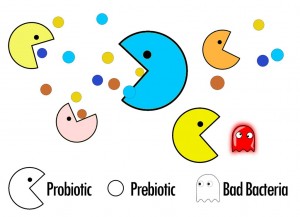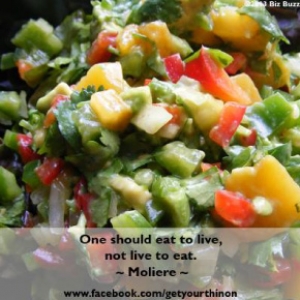Education is learning what you didn’t even know you didn’t know. ~ Daniel Boorstin
Just a decade ago, the words probiotics and  were rare. By now, while most have heard the words; all they really know is it has something to do with gut health.
were rare. By now, while most have heard the words; all they really know is it has something to do with gut health.
Gut health.
Who knew digestion of food, our basic energy source, would be the prime focus in the total health world today? More and more science is saying digestion, and in conjunction, elimination, are two of the most important body systems we can work on to achieve optimal health.
So what are probiotics and prebiotics and how can they help?
First, let’s consider something familiar to us … antibiotics. Breaking it down anti means opposite … biotic means living things. Combining the word parts carries the meaning of not living. Basically, antibiotics kill off living things. When taking an antibiotic, your hope is to destroy the organisms making you sick.
A key point: Antibiotics, not only kill bad bacteria, but the good as well. After completing an antibiotic regimen, it is imperative to replace and start rebuilding the good bacteria in your intestines.
The prefix pro often means move forward or growth. A pro-biotic would therefore tell us it encourages the growth of living things.
The prefix pre means before, thus a pre-biotic means this particular thing exists before the emergence of life. They aren’t really living things. What is their purpose in the cycle?
In order for pro-biotics to live, they need a fuel source; call in the pre-biotics.
Formally defined:
Probiotics: Friendly microorganisms inhabiting our digestive tract aiding and supporting digestion and including additional health benefits.
Prebiotics: Non-living, non-digestible organisms serving as Probiotics’ food source.
Let’s go deeper.
In simple terms, probiotics are the bacteria living in our intestinal tract. They get there either by the foods we eat (great!) or the supplements we might take (not so great).
There are oodles of probiotic types and each one is responsible for something different in the gut.
Although the mention of the word probiotic is relatively new (starting to appear somewhere around 1980) different cultures around the world have been ingesting them for thousands of years in the form of cultured or fermented foods.
As a side point, I find it interesting most cultures have a fermented food as a regular dietary addition, whereas America does not. Just one of those things that make me go hmmmmmm. Check out this short list:
Kimchi: Korea
Tofu: Chinese
Crème fraîche: French
Strained Yogurt: Middle East
Sauerkraut: Germany
Why are probiotics important? To be frank, science is only starting to understand the relationship between our gut, the bacteria, and the rest of our bodies. What they do know for sure is probiotics can help keep us regular, improve our immune system, and help fight some diseases (and that’s just a start).
We learned in science class every living thing needs a fuel source to stay alive. For probiotics that fuel source is prebiotics.
Prebiotics are the food required for probiotics to survive and flourish. You can take huge amounts of probiotics and still have a weak body system because you haven’t given that good bacteria a lush environment in which to grow.
As we learned before, prebiotics are not living, they are a non-digestible food ingredient promoting beneficial microorganisms’ growth in the intestines.
In short … they are fiber.
Do you get enough fiber every day? I am going to assume not, especially if you live off a high fat low carb diet. Would it surprise you to learn you can still do HFLC and get the necessary fiber in to help your gut?
Here is just a quick list of prebiotics rich foods:
Jicama
Jerusalem artichokes
Avocados
Peas
Potato skins
Apple cider vinegar (organic only)
How much do you need to take? Well, that really depends on you and your body. This is one of those things to start slow and build until you don’t feel good anymore and then back off. The accepted dose is between 5 and 30 grams a day. Please remember I said to start SLOW. If you are brand new to adding this kind of fiber to your daily diet, start with 5 grams a day for a week or two and then increase.
I have only scratched the surface on this subject; however, I foresee many more articles in the future. ::giggle::
Remember, when your intestinal tract has ample beneficial bacteria (and the fuel that feeds them), you can experience better overall health from a physical, mental and emotional standpoint. You’ll be better nourished, feel fuller, and able to achieve and maintain a healthy weight much easier.
IMPORTANT NOTE: People with Small Intestinal Bacterial Overgrowth (SIBO) often find prebiotics are the exact opposite of what they need (if you already have too many bacteria, feeding them even more is not going to help).
Many people with Irritable Bowel Syndrome or FODMAPs intolerance find prebiotics make their symptoms worse.
If you’re in one of these categories, or if you feel bloated, uncomfortable, constipated, or generally gross after eating foods high in prebiotics, then they may not be for you at this time.
If you have any specific questions on the Probiotic/Prebiotic subject you would like addressed in a future article, please respond below.















